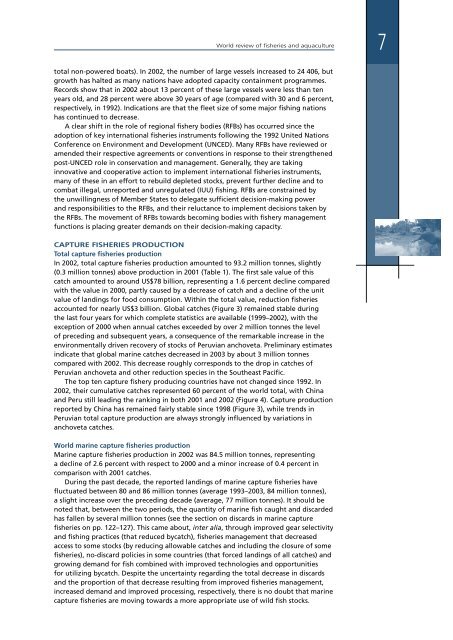State of World Fisheries and Aquaculture 2004 - Library
State of World Fisheries and Aquaculture 2004 - Library
State of World Fisheries and Aquaculture 2004 - Library
Create successful ePaper yourself
Turn your PDF publications into a flip-book with our unique Google optimized e-Paper software.
<strong>World</strong> review <strong>of</strong> fisheries <strong>and</strong> aquaculture<br />
7<br />
total non-powered boats). In 2002, the number <strong>of</strong> large vessels increased to 24 406, but<br />
growth has halted as many nations have adopted capacity containment programmes.<br />
Records show that in 2002 about 13 percent <strong>of</strong> these large vessels were less than ten<br />
years old, <strong>and</strong> 28 percent were above 30 years <strong>of</strong> age (compared with 30 <strong>and</strong> 6 percent,<br />
respectively, in 1992). Indications are that the fleet size <strong>of</strong> some major fishing nations<br />
has continued to decrease.<br />
A clear shift in the role <strong>of</strong> regional fishery bodies (RFBs) has occurred since the<br />
adoption <strong>of</strong> key international fisheries instruments following the 1992 United Nations<br />
Conference on Environment <strong>and</strong> Development (UNCED). Many RFBs have reviewed or<br />
amended their respective agreements or conventions in response to their strengthened<br />
post-UNCED role in conservation <strong>and</strong> management. Generally, they are taking<br />
innovative <strong>and</strong> cooperative action to implement international fisheries instruments,<br />
many <strong>of</strong> these in an effort to rebuild depleted stocks, prevent further decline <strong>and</strong> to<br />
combat illegal, unreported <strong>and</strong> unregulated (IUU) fishing. RFBs are constrained by<br />
the unwillingness <strong>of</strong> Member <strong>State</strong>s to delegate sufficient decision-making power<br />
<strong>and</strong> responsibilities to the RFBs, <strong>and</strong> their reluctance to implement decisions taken by<br />
the RFBs. The movement <strong>of</strong> RFBs towards becoming bodies with fishery management<br />
functions is placing greater dem<strong>and</strong>s on their decision-making capacity.<br />
CAPTURE FISHERIES PRODUCTION<br />
Total capture fisheries production<br />
In 2002, total capture fisheries production amounted to 93.2 million tonnes, slightly<br />
(0.3 million tonnes) above production in 2001 (Table 1). The first sale value <strong>of</strong> this<br />
catch amounted to around US$78 billion, representing a 1.6 percent decline compared<br />
with the value in 2000, partly caused by a decrease <strong>of</strong> catch <strong>and</strong> a decline <strong>of</strong> the unit<br />
value <strong>of</strong> l<strong>and</strong>ings for food consumption. Within the total value, reduction fisheries<br />
accounted for nearly US$3 billion. Global catches (Figure 3) remained stable during<br />
the last four years for which complete statistics are available (1999–2002), with the<br />
exception <strong>of</strong> 2000 when annual catches exceeded by over 2 million tonnes the level<br />
<strong>of</strong> preceding <strong>and</strong> subsequent years, a consequence <strong>of</strong> the remarkable increase in the<br />
environmentally driven recovery <strong>of</strong> stocks <strong>of</strong> Peruvian anchoveta. Preliminary estimates<br />
indicate that global marine catches decreased in 2003 by about 3 million tonnes<br />
compared with 2002. This decrease roughly corresponds to the drop in catches <strong>of</strong><br />
Peruvian anchoveta <strong>and</strong> other reduction species in the Southeast Pacific.<br />
The top ten capture fishery producing countries have not changed since 1992. In<br />
2002, their cumulative catches represented 60 percent <strong>of</strong> the world total, with China<br />
<strong>and</strong> Peru still leading the ranking in both 2001 <strong>and</strong> 2002 (Figure 4). Capture production<br />
reported by China has remained fairly stable since 1998 (Figure 3), while trends in<br />
Peruvian total capture production are always strongly influenced by variations in<br />
anchoveta catches.<br />
<strong>World</strong> marine capture fisheries production<br />
Marine capture fisheries production in 2002 was 84.5 million tonnes, representing<br />
a decline <strong>of</strong> 2.6 percent with respect to 2000 <strong>and</strong> a minor increase <strong>of</strong> 0.4 percent in<br />
comparison with 2001 catches.<br />
During the past decade, the reported l<strong>and</strong>ings <strong>of</strong> marine capture fisheries have<br />
fluctuated between 80 <strong>and</strong> 86 million tonnes (average 1993–2003, 84 million tonnes),<br />
a slight increase over the preceding decade (average, 77 million tonnes). It should be<br />
noted that, between the two periods, the quantity <strong>of</strong> marine fish caught <strong>and</strong> discarded<br />
has fallen by several million tonnes (see the section on discards in marine capture<br />
fisheries on pp. 122–127). This came about, inter alia, through improved gear selectivity<br />
<strong>and</strong> fishing practices (that reduced bycatch), fisheries management that decreased<br />
access to some stocks (by reducing allowable catches <strong>and</strong> including the closure <strong>of</strong> some<br />
fisheries), no-discard policies in some countries (that forced l<strong>and</strong>ings <strong>of</strong> all catches) <strong>and</strong><br />
growing dem<strong>and</strong> for fish combined with improved technologies <strong>and</strong> opportunities<br />
for utilizing bycatch. Despite the uncertainty regarding the total decrease in discards<br />
<strong>and</strong> the proportion <strong>of</strong> that decrease resulting from improved fisheries management,<br />
increased dem<strong>and</strong> <strong>and</strong> improved processing, respectively, there is no doubt that marine<br />
capture fisheries are moving towards a more appropriate use <strong>of</strong> wild fish stocks.

















